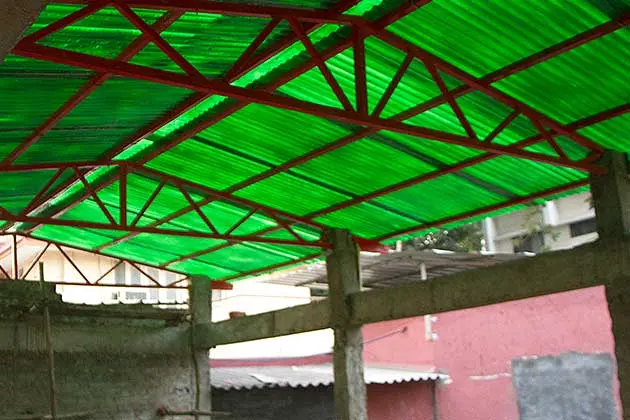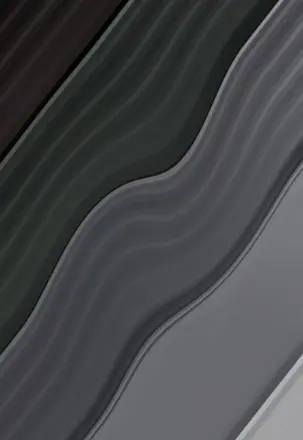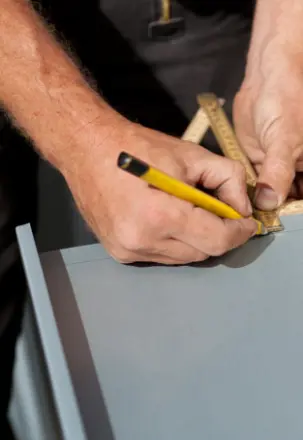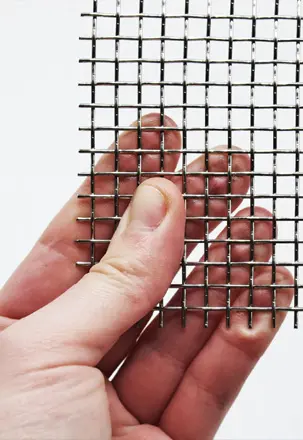
Fiber-reinforced plastic (FRP) roofing sheets are a type of roofing material that is made from a composite of fiberglass and plastic. These sheets are known for their durability, strength, and resistance to various environmental conditions. FRP roofing sheets are commonly used in industrial, commercial, and residential applications.
Some key characteristics and benefits of FRP roofing sheets include:
- Durability: FRP roofing sheets are highly durable and can withstand harsh weather conditions, UV rays, and chemicals.
- Lightweight: They are relatively lightweight compared to traditional roofing materials, making them easier to handle and install.
- Corrosion Resistance: FRP is resistant to corrosion, making it suitable for use in areas with high humidity or exposure to corrosive substances.
- Transparency: Some FRP sheets are translucent, allowing natural light to pass through. This can be beneficial in areas where daylighting is desired.
- Versatility: FRP roofing sheets come in various shapes, sizes, and colors, providing flexibility in design and application.
- Low Maintenance: They require minimal maintenance and are easy to clean.
- Insulating Properties: FRP has good insulating properties, helping to regulate temperature.
Before choosing FRP roofing sheets for a specific application, it’s important to consider factors such as the type of environment, required load-bearing capacity, and specific project requirements. Additionally, local building codes and regulations should be consulted to ensure compliance.
If you have specific questions or need more detailed information about FRP roofing sheets, feel free to ask!

The use of Fiber-Reinforced Plastic (FRP) roofing sheets comes with several benefits, making them a popular choice for various applications. Here are some key advantages:
- Durability: FRP roofing sheets are known for their high durability. They can withstand harsh weather conditions, extreme temperatures, and are resistant to corrosion. This durability contributes to a longer lifespan compared to some traditional roofing materials.
- Lightweight: FRP sheets are relatively lightweight, making them easier to handle during transportation and installation. This characteristic can lead to cost savings in terms of labor and logistics.
- Chemical Resistance: FRP is resistant to chemicals, making it suitable for environments where exposure to corrosive substances is a concern. This makes FRP roofing sheets an ideal choice for industrial settings or areas with chemical exposure.
- Transparency (if applicable): Some FRP sheets are translucent, allowing natural light to pass through. This feature, known as daylighting, can reduce the need for artificial lighting during the day and contribute to energy savings.
- Versatility: FRP roofing sheets come in various shapes, sizes, and colors, providing flexibility in design. This versatility allows for customization to meet specific aesthetic and functional requirements.
- Low Maintenance: FRP requires minimal maintenance. Regular cleaning is typically sufficient to keep the roofing sheets in good condition. This can lead to additional cost savings over time.
- Insulating Properties: FRP has good insulating properties, helping to regulate temperature. This insulation can contribute to energy efficiency by reducing heating and cooling costs.
- Environmental Considerations: Some FRP roofing sheets are made from recycled materials, and the lightweight nature of FRP can contribute to fuel efficiency during transportation, reducing the environmental impact.
It’s important to note that the specific benefits may vary based on the type of FRP roofing sheet, the application, and environmental conditions. Before choosing FRP for a particular project, it’s advisable to assess specific requirements and consult with experts to ensure the suitability of the material.

Polycarbonate sheets are a type of thermoplastic material known for their versatility and various applications. Here are some key features and uses of polycarbonate sheets:
Key Features:
- Transparency: Polycarbonate sheets are highly transparent, allowing light to pass through. This property makes them suitable for applications where clarity and visibility are important.
- High Impact Resistance: Polycarbonate is extremely durable and impact-resistant. It is much stronger than glass and less prone to breakage, making it a safer option in certain applications.
- Lightweight: Polycarbonate sheets are lightweight, which makes them easy to handle and install. This characteristic is particularly beneficial in construction and other industries where weight considerations are important.
- UV Resistance: Many polycarbonate sheets are treated to resist UV radiation. This UV resistance prevents yellowing and degradation over time when exposed to sunlight, making them suitable for outdoor applications.
- Thermal Insulation: Polycarbonate sheets have good thermal insulation properties. They can help regulate temperature and contribute to energy efficiency.
- Versatility: Polycarbonate sheets come in various forms, including solid sheets, multiwall sheets, and corrugated sheets. They can be easily shaped, cut, and molded, offering versatility in design and application.
Common Applications:
- Roofing: Polycarbonate sheets are widely used in roofing applications, providing natural light while offering durability and impact resistance.
- Skylights: The transparency of polycarbonate makes it an ideal material for skylights, allowing natural light to illuminate interior spaces.
- Greenhouses: The combination of light transmission and durability makes polycarbonate sheets popular for greenhouse construction, providing an optimal environment for plant growth.
- Signage: Polycarbonate is used for outdoor signage due to its impact resistance and transparency.
- Safety Shields: Its high impact resistance makes polycarbonate suitable for manufacturing safety shields, protective barriers, and machine guards.
- Automotive Applications: Polycarbonate is used in automotive applications, such as headlights and interior components, due to its impact resistance and lightweight nature.
- Electrical Components: Transparent polycarbonate is used in the production of electrical components, including covers for electrical panels.
It’s important to consider the specific type of polycarbonate sheet based on the requirements of the application, as there are variations in thickness, structure, and coatings that cater to different needs.

The use of polycarbonate sheets comes with several benefits due to their unique properties and versatility. Here are some key advantages:
- High Impact Resistance: One of the primary benefits of polycarbonate sheets is their exceptional impact resistance. They are much stronger than glass and less prone to breakage, making them a safer option in applications where durability is crucial.
- Transparency: Polycarbonate sheets are highly transparent, allowing a significant amount of light to pass through. This makes them an excellent choice for applications where clarity and visibility are important, such as in skylights, greenhouses, and transparent barriers.
- Lightweight: Polycarbonate sheets are lightweight, which simplifies handling, transportation, and installation. This characteristic is particularly advantageous in construction and other industries where minimizing weight is a consideration.
- UV Resistance: Many polycarbonate sheets are treated to resist UV radiation. This UV resistance prevents yellowing and degradation over time when exposed to sunlight, making them suitable for outdoor applications without compromising their optical clarity.
- Thermal Insulation: Polycarbonate sheets have good thermal insulation properties. They can help regulate temperature, making them suitable for applications where insulation is important, such as roofing and greenhouse construction.
- Versatility in Design: Polycarbonate sheets come in various forms, including solid sheets, multiwall sheets, and corrugated sheets. Their versatility in terms of shapes and forms allows for creative and customized designs in different applications.
- Durability: Polycarbonate sheets exhibit durability and longevity, with resistance to weathering, chemicals, and impact. This durability contributes to a longer lifespan and reduces the need for frequent replacements or maintenance.
- Wide Range of Applications: Polycarbonate sheets find applications in diverse industries, including construction, agriculture, automotive, signage, and more. Their adaptability makes them suitable for a broad range of uses.
- Energy Efficiency: The thermal insulation properties of polycarbonate contribute to energy efficiency in buildings by helping to maintain stable temperatures and reducing the need for additional heating or cooling.
- Recyclability: Polycarbonate is recyclable, which aligns with sustainability goals in construction and manufacturing.
It’s important to note that the specific benefits may vary depending on the type of polycarbonate sheet and its intended application. Consideration of factors such as thickness, structure, and coatings is essential to choose the most suitable product for a given purpose.
The choice between Fiber-Reinforced Plastic (FRP) and polycarbonate depends on the specific requirements of your application. Both materials have their advantages, and the decision should be based on factors such as durability, transparency, impact resistance, and intended use. Here’s a comparison of the two:
FRP (Fiber-Reinforced Plastic):
- Durability: FRP is known for its high durability and resistance to various environmental conditions. It is particularly robust and can withstand harsh weather, chemicals, and corrosion.
- Weight: FRP is relatively lightweight, making it easy to handle during installation. This can be an advantage in construction projects.
- Chemical Resistance: FRP is resistant to chemicals, making it suitable for applications where exposure to corrosive substances is a concern.
- Transparency: While FRP can be translucent, it is not as transparent as polycarbonate. If transparency is a crucial factor, you may want to consider this.
Polycarbonate:
- Transparency: Polycarbonate sheets are highly transparent, allowing a significant amount of light to pass through. This makes them ideal for applications where clarity and visibility are essential.
- Impact Resistance: Polycarbonate is known for its high impact resistance, surpassing traditional glass. It is less prone to breakage, making it a safer option in certain applications.
- Weight: Polycarbonate sheets are lightweight, facilitating easier handling and installation. This is advantageous in various industries.
- UV Resistance: Many polycarbonate sheets are treated to resist UV radiation, preventing yellowing and degradation over time when exposed to sunlight.
- Thermal Insulation: Polycarbonate has good thermal insulation properties, which can contribute to energy efficiency in certain applications.
Considerations:
- If transparency is a critical factor and you need a material that is close to the optical clarity of glass, polycarbonate might be a better choice.
- If your application requires high durability, resistance to chemicals, and a material that is still relatively lightweight, FRP could be suitable.
- Consider the specific environmental conditions and performance requirements of your project to make an informed decision.
Ultimately, the better choice depends on the specific needs of your application, and it’s advisable to consult with professionals or experts in the field for a more tailored recommendation.











